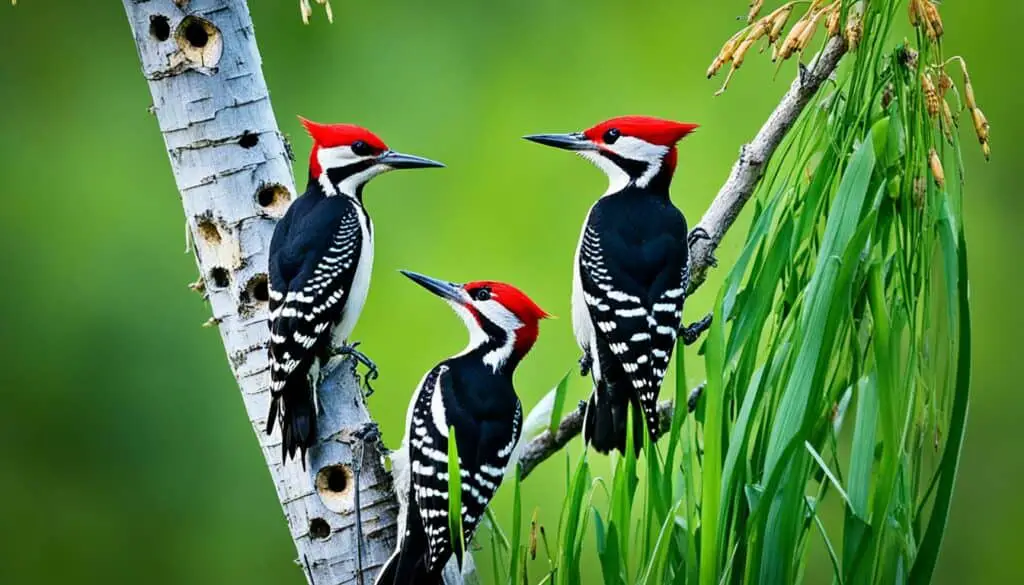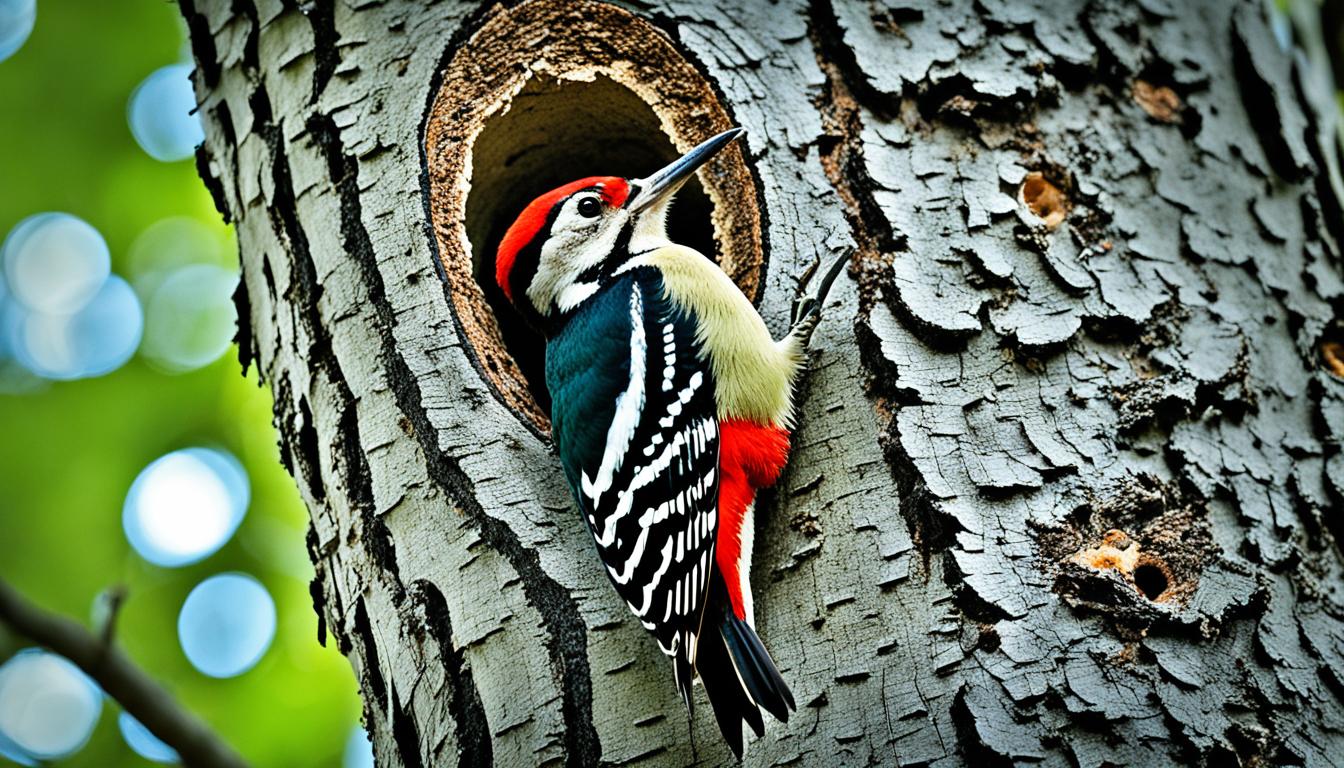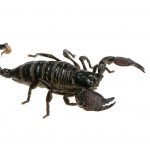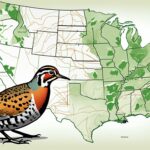Have you thought about where the rhythmic drumming of a woodpecker is most common?
Woodpeckers belong to the Picidae family and they choose various habitats worldwide. With 236 different kinds, such as the Downy, Red-headed, and Pileated Woodpeckers, their habitat choices are diverse.
Usually, woodpeckers like places with a lot of trees. This can be savannahs, scrublands, or even bamboo forests. Their bills are designed for drilling into trees, where they also make their homes. The best places for woodpeckers have lots of dead or decaying trees. This is very important for their food finding.
Knowing about the habitats of woodpeckers helps us understand more about them. It shows us the different places they live and why.
Wooded Habitats for Woodpeckers
Woodpeckers need wooded areas to survive. They find food and shelter in forests. These ideal habitats for woodpeckers are all over the world, especially where there are many trees. You can see them in places like Africa, Southeast Asia, and even North America.
Forest Types
Woodpeckers do well in different types of forests. There are deciduous, coniferous, and mixed woodlands. Each place has its own good points and things to watch out for:
- Deciduous Forests: have a lot of different bugs for woodpeckers to eat.
- Coniferous Forests: have trees that stay green all year and produce resin.
- Mixed Woodlands: combine the benefits of both deciduous and coniferous forests.
Importance of Deadwood
Deadwood is key for woodpecker habitats. It’s vital for food and making nests. Having deadwood around helps woodpeckers look for food effectively and find safe places to sleep.
| Forest Type | Key Features | Woodpecker Benefits |
|---|---|---|
| Deciduous | Seasonal foliage, rich insect life | Ample insect food sources |
| Coniferous | Evergreen trees, resinous wood | Year-round shelter, food from tree sap |
| Mixed Woodlands | Combination of deciduous and coniferous trees | Variety in food and nest options |
Woodpecker Habitat Preferences in North America
North America hosts many woodpecker types, each liking different places to live. They enjoy areas from forests filled with oak and beech to those with pine and spruce. Knowing where they like to be helps us keep their homes safe.
Deciduous Forests
Deciduous forests, full of oak and beech, are the top choice for woodpeckers. The Red-headed Woodpecker, for example, finds plenty of food and homes here. It nests in dead trees within these forests, making use of the available ecosystem.
Coniferous Forests
Other woodpeckers like the Pileated Woodpecker prefer coniferous, which have thick tree cover. Foraging, finding food or bugs, is easier with this cover. They peck into pine, spruce, and fir trees to hunt insects and to nest.
Mixed Woodlands
Mixed woodlands, a blend of the two forest types, suit some woodpeckers like the Downy Woodpecker. These places have diverse trees, offering various food sources. The Downy Woodpecker, for one, uses different trees for nesting and finding food.
| Forest Type | Species | Key Characteristics |
|---|---|---|
| Deciduous Forests | Red-headed Woodpecker | Rich in oak and beech, ample deadwood for nesting |
| Coniferous Forests | Pileated Woodpecker | Dense tree cover, vital for foraging |
| Mixed Woodlands | Downy Woodpecker | Diverse vegetation, varied food sources |
Urban and Suburban Habitats
Woodpeckers love natural wooded areas. Yet, they’ve shown they can live in towns and cities too. They make use of the various locations in these places for food and homes. This includes city parks and areas where people live. Their skill at adapting to places shaped by people is truly impressive.
Adaptation to Urban Areas
Woodpeckers adapting to cities is quite fascinating. They find ways to live in trees along streets and in green spaces. They can also live in big gardens for food and shelter. This shows how they can change and find new homes as the world changes.
The woodpeckers in cities pick trees that are high and offer lots of cover. This keeps them safe from people while they look for food. So, they’re smart about where they live.
Common Sites in Suburbs
In the suburbs, woodpeckers show up in various places. This includes our backyards and parks with big, old trees. Adding native plants and keeping the trees well help bring woodpeckers in. They also like areas where there are many bugs to eat.
If we want to help these birds, we should take care of green spaces in the suburbs. This means not cutting down too many trees and keeping gardens friendly for wildlife.
“Urban and suburban woodpeckers bring a slice of the wild into our daily lives, highlighting the importance of preserving and nurturing green spaces within our cities.” – Ornithologist Jamie F. Smith
| Urban Habitat Feature | Suburban Habitat Feature |
|---|---|
| City Parks | Backyards |
| Street Trees | Local Parks |
| Large Gardens | Wooded Buffers |
| Urban Forests | Green Corridors |
Grasslands and Open Woodlands
Woodpeckers are known for their ability to live in various places. They can make homes in not just thick forests, but also in areas like grasslands and open woodlands. In these spots, trees are few and far between. But woodpeckers handle this challenge well. They adjust their behaviors for finding food and building nests in these special areas.
Nesting in Sparse Trees
Nesting in sparse trees is a smart move for woodpeckers. Especially, when living in grasslands and open woodlands. These birds make their homes in the few trees around. This way, they keep their eggs and young safe as they grow. The isolated trees are like a golden ticket for woodpeckers to start their families.
Foraging Behavior
In these settings, woodpeckers show how adaptable they are with their feeding habits. They look for insects under the tree bark or logs. But, they also check the ground for ants and other bugs. This double approach to finding food helps them succeed even in areas with not many trees.
Savannahs and Scrublands
Savannahs and scrublands feature open spaces mixed with woody growth. This makes them great for woodpeckers. They offer a special kind of land where woodpeckers find plenty of food. This includes insects in the trees and those in the ground.
Woodpeckers are amazing at living in scrublands, even with few trees around. They use smart strategies to make the most of these places. Despite not having many trees, they thrive. The rich mix of insects and small animals in these spots means they never run out of food.
In these areas, woodpeckers are quick to spot and use available resources. The mix of some trees and lots of open space creates a spot where woodpeckers can thrive. Their ability to live in scrublands is not just about surviving. It also helps their numbers grow.
Wetlands and River Bottoms
Wetlands like river bottoms are great for many woodpecker species. They have plenty of dead trees and softwood for nesting and searching for food. This makes them perfect places for woodpeckers to live.

Beaver Swamps
Beaver swamps are top spots in wetlands because they have a lot of dead trees. Beavers make these deadwood by building dams. These trees are perfect for woodpecker nests and the bugs there are good to eat.
In beaver swamps, you also find open water among fallen trees. This setting is like a buffet for woodpeckers.
Floodplain Forests
Floodplain forests next to river bottoms are key in wetland areas. Flooding leaves many standing dead trees. This is great for woodpeckers, who find lots of places to nest and food to eat. Wetness and nutrients also mean lots of insects, a big win for woodpeckers.
The Red-headed Woodpecker, in particular, thrives in such environments, benefiting tremendously from the variety of available nesting sites and food resources.
Here is a comparative look at key habitat features:
| Feature | Beaver Swamps | Floodplain Forests |
|---|---|---|
| Dead Tree Availability | High | High |
| Insect Population | Abundant | Rich |
| Nesting Sites | Plentiful | Numerous |
Bamboo Forests and Dense Vegetation
Woodpeckers really like bamboo forests. They find lots of food there, like bugs and sap. Plus, the forests are perfect for building their nests. The thick plants help hide them, too.
Bamboo forests are just right for woodpeckers, thanks to their complex structure. The plants keep them safe from other animals. They also have plenty of old bamboo to make homes in.
Woodpeckers are smart to choose such rich habitats. These areas ensure they get all they need to live. This is true whether we’re talking about places like Southeast Asia or South America. It shows how important bamboo forests are for these birds’ lives, too.
Influences on Woodpecker Habitat Preferences
What shapes woodpecker homes tells us a lot. It shows their needs and how they survive. The main things influencing their choices are the weather and where they can find food. These help decide where woodpeckers can live and how they adjust to different places in the U.S.
Influence of Climate
Climate is key in knowing where woodpeckers live. They are in places with many different climates, such as cool forests and warm areas. The weather, rain, and seasons of an area affect what trees are there and how much deadwood there is. Woodpeckers in cold places, for example, might prefer evergreen forests. Those in warm areas could pick from many kinds of places with trees.
Availability of Food Sources
The food around also shapes woodpecker homes. They eat mostly bugs, but also fruit, nuts, and tree sap. Places with lots of these foods draw woodpeckers in. For instance, areas with many bug-infested trees are great for feeding.
But, places with little food see fewer woodpeckers. This balance of weather and food shows why woodpeckers live where they do. Learning about these helps us see how woodpeckers can fit in many kinds of areas.
FAQ
What types of habitats do woodpeckers prefer?
Woodpeckers like a range of places such as forests and open lands. They need places with lots of trees. These areas have plenty of spots for them to find food and build their homes.
What types of wooded habitats are ideal for woodpeckers?
They enjoy big forests with many tree types. This includes forests with leaves that fall off, evergreen trees, and a mix of both. Such places are great for them to look for bugs and make their homes.
Why is deadwood important for woodpeckers?
Deadwood is very important for woodpeckers. It gives them places to make their nests. Also, it’s full of bugs they can eat.
What are woodpecker habitat preferences in North America?
In North America, woodpeckers like many different forest types. This ranges from ones with trees that lose their leaves to those that stay green all year round. They also do well in forests with a mix of both kinds of trees.
How do woodpeckers adapt to urban areas?
Woodpeckers find ways to live in cities and towns. They might use parks or places where there are plenty of trees. They can even make their homes in buildings if they can find a good spot.
What are common sites for woodpeckers in suburban areas?
You might find woodpeckers in yards, parks, and gardens in the suburbs. If there are enough trees, they can make their homes in them. Or, they might use places made by people for nesting.
How do woodpeckers nest in grasslands and open woodlands?
In these places, woodpeckers choose some trees or small woods to nest in. They also look for insects in these spots.
Woodpeckers change how they look for food based on what’s around.
What is woodpecker foraging behavior in these habitats?
In grasslands and open woods, they look for food by digging into trees. This allows them to find insects to eat. They also enjoy eating fruits, nuts, and tree sap.
How do woodpeckers fare in savannahs and scrublands?
These places can be good for woodpeckers because of the mix of open areas and some trees. It gives them a chance to find a variety of foods and places to make their nests.
What are favorable wetland habitats for woodpeckers?
Wet areas like beaver swamps and forests by the water are great for woodpeckers. They have lots of dead trees for homes. Plus, there are many insects for them to eat.
Are bamboo forests suitable for woodpeckers?
Yes, certain woodpeckers like bamboo forests. These places are full of food and have many spots to make their nests.
How does climate influence woodpecker habitat preferences?
The weather affects where woodpeckers live. They pick places with food and shelter that matches the climate. This helps them survive and find what they need to eat.
What factors determine the availability of food sources for woodpeckers?
Food for woodpeckers includes bugs, fruits, nuts, and tree sap. Places with many types of plants and a lot of deadwood are great for finding food.







